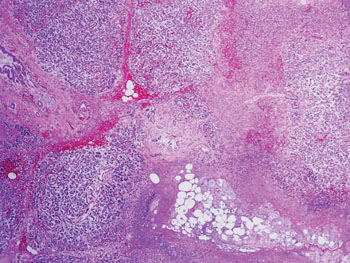Mild-to-Moderate Hypertriglyceridemia Leads to Acute Pancreatitis
By LabMedica International staff writers
Posted on 23 Nov 2016
Pancreatitis is very painful and it may lead to fatalities and until now, medical science has connected the risk of developing this illness to gallstone, a high intake of alcohol and very high concentrations of blood fats or triglycerides.Posted on 23 Nov 2016
Normal levels of blood triglycerides would typically be 0-2 mmol/L, while 2-10 is classified as a mild to moderate increase. If blood fat levels rise above 10 mmol/L it is considered a very high increase and previously, this was considered the risk factor to look for in relation to pancreatitis.

Image: A histopathology of acute pancreatitis showing hemorrhage, parenchymal necrosis, and fat necrosis (Photo courtesy of Kathryn Lindsey, MD).
Clinical biochemists and their colleagues at the Copenhagen University Hospital (Herlev, Denmark) carried out a prospective cohort study examines individuals from the Copenhagen General Population Study in 2003 to 2015 and the Copenhagen City Heart Study initiated in 1976 to 1978 with follow-up examinations in 1981 to1983, 1991 to 1994, and in 2001 to 2003. Median follow-up was 6.7 years and includes 116, 550 individuals with a triglyceride measurement from the Copenhagen General Population Study and the Copenhagen City Heart Study. All individuals were followed until the occurrence of an event, death, emigration, or end of follow-up, in November 2014.
The scientists showed that even a 2 mmol/L significantly increases the risk of pancreas inflammation, and the risk is nine times higher with blood triglycerides levels at 5-10 mmol/L. Compared with individuals with plasma triglyceride levels less than 89 mg/dL (<1 mmol/L), the multivariable adjusted hazard ratios (HRs) for acute pancreatitis were 1.6; for individuals with triglyceride levels of 89 mg/dL to 176 mg/dL, HR was 2.3. The HRs increased as triglycerides incrementally until for individuals with triglyceride levels greater than or equal to 443 mg/dL (≥5.00 mmol/L), the HR reached 8.7. Corresponding HRs for myocardial infarction were followed a similar correlation.
Børge Nordestgaard, MD, DMSc, a professor and the lead investigator said, “Until now, medical science has focused primarily on high blood cholesterol, but our study shows that we should also pay attention to more common fats. Mild to moderate levels of blood fats cause a lot more diseases than we have hitherto been aware of and we need many more studies in this area. I know that currently studies are undertaken that investigate whether lowering the levels of blood fats also lowers the risk of developing cardiovascular diseases.” The study was published on November 7, 2016, in the Journal of the American Medical Association Internal Medicine.
Related Links:
Copenhagen University Hospital









 Analyzer.jpg)




